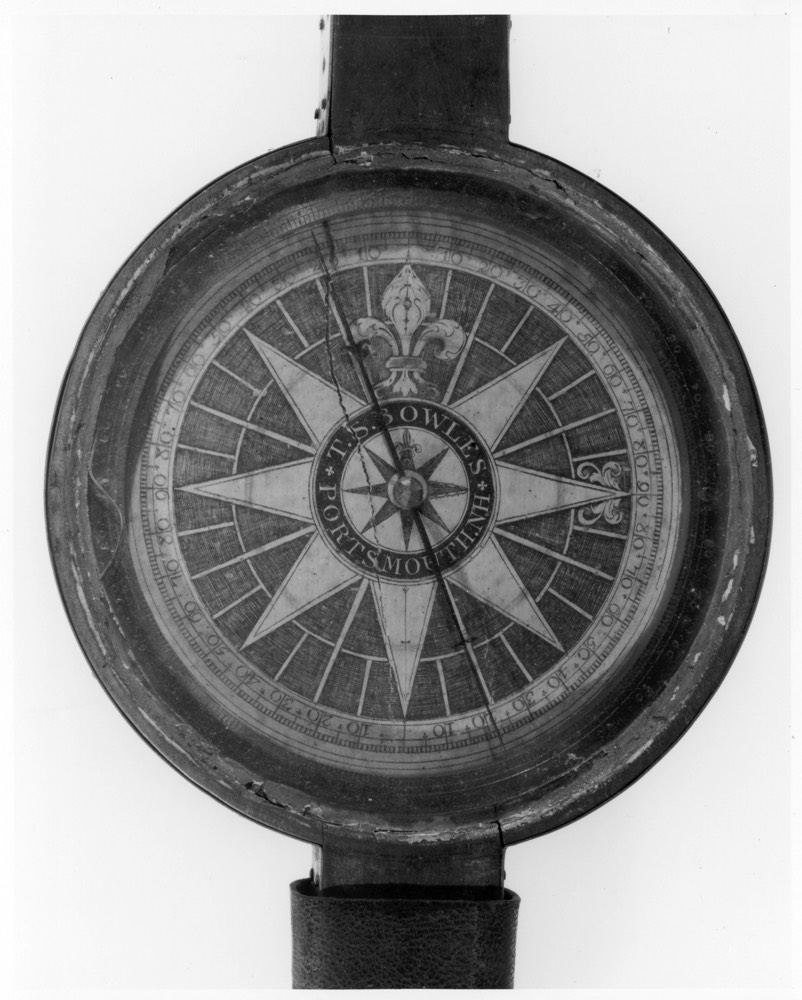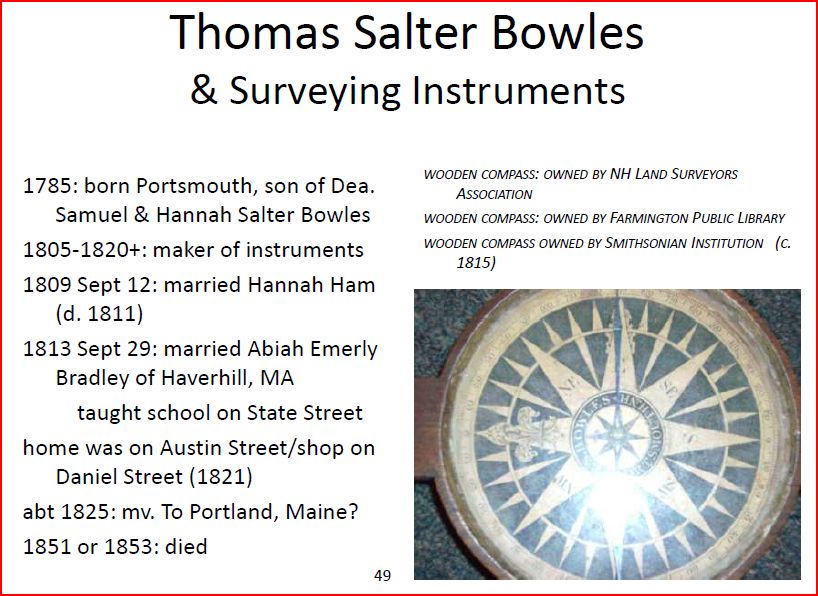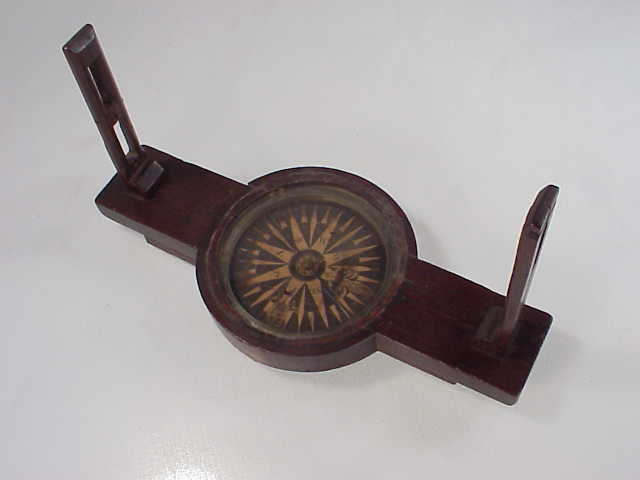
Thomas Bowles
History
Thomas Salter Bowles
1785-1853
Thomas Salter Bowles was born in 1785 in Portsmouth NH he died July 26, 1853. He married Abiah Emery Bradley on September 29, 1813, she was born on October 30, 1788 in Haverhill MA and died on February 8, 1878 in Boston, MA.
Little is known about the work of Bowles as an instrument maker except through a few of his instruments. Bowles was a mathematical instrument maker who had just taken a shop in Daniel Street, and that his wares included "Azimuth and brass Compasses, wood and Hanging Compasses." Bowles was still in business in 1821. He is listed in the first Portsmouth directory, of 1821, as a "mathematical instrument maker" with a place of business on Daniel Street; his home was given as Austin Street in Portsmouth. He did not appear in the city's directories of 1827 and 1834. It is assumed that he may have left Portsmouth in the interim, possibly to settle in his wife's home town of Haverhill.
Bowles is another elusive New England instrument maker about whom little information is available. He is believed to have been the son of Deacon Samuel and Hannah (Salter) Bowles, and was baptized in Portsmouth, N.H., in 1785. His father was born in 1739; his mother, who was the daughter of Captain Titus Salter, was born in 1748 and died in 1831. Deacon Bowles was clerk of the Brick Market in Portsmouth from 1801 to the time of his death, November 3, 1802. There is a minimum of information available from church and city records in the community, but it is believed that he was a member of one of the offshoots of the established Puritan Church, and hence he would not appear in its records. He kept the lower school in the Brick School House on State Street for a number of years.
It is believed that the Bowles family first came to Portsmouth during the few years immediately before the beginning of the Revolutionary War. It is known that a Thomas Bowles and a Samuel Bowles both signed the Association Test on August 14, 1776, promising to oppose the hostile proceedings of the British fleets and armies. Furthermore, one of the principal taxpayers in Portsmouth in 1770 was a firm named Griffith and Bowles, which paid £17 in taxes in 1770. The name of the Bowles who formed part of this firm is not known, but it was either Samuel or the first Thomas Bowles. The other partner was Nathaniel S. Griffith, a watchmaker. It is possible that a tradition of instrument making existed in the Bowles family even then.
On file in the office of the City Clerk in Portsmouth are two certificates of marriage made out by Thomas Salter Bowles. The first is for his marriage to Hannah Ham, a ceremony performed on September 21, 1809, by Joseph Walton, one of the pastors of a church dissenting from the Puritan regime. Hannah was the daughter of William Ham, a brother of Supply Ham (1788-1862), a noted local clockmaker. Bowles may have served an apprenticeship in that shop before he married Hannah. Two other members of the Ham family George Ham and Henry H. Ham worked as watchmakers in Portsmouth in the same period. A search of the cemeteries has indicated that Hannah Ham Bowles died in 1811, age 20. She is buried with her infant son in North Cemetery. Thomas Bowles's second marriage certificate in Portsmouth is for his marriage on September 29, 1813 two years after Hannah's death to Abiah Emerly Bradley of Haverhill, Massachusetts.
Three instruments signed by Bowles have survived, and all show signs of considerable wear. They are surveying compasses made of walnut, having maple sighting bars and a silvered brass vernier set under the glass. Two examples, one in the Streeter Collection of Weights and Measures at Yale University and one owned by this writer are almost identical in size, form, and details. The only variation is that the Yale example has a bubble level under a brass strip set into one end, an item lacking in the other exampIe. The most interesting of the three instruments was acquired by the Dartmouth Museum as part of a collection of the late Frank C. Churchill, an inspector in the Indian Service.
The compass card, made from a line engraving, is identical in each of the three examples. A floriated fleur-de-lis on the North[Pg 126]point has a compass and square at its base, and the name T. S. BOWLES is on a riband over it. Adorning the East point is an American eagle bearing a shield with stars and stripes and clutching arrows in one claw and a laurel twig in the other. In a ring within the central medallion is inscribed (see fig. 68), "* T. S. BOWLES *PORTSMOUTH, N.H. *"
The most interesting of the three instruments was acquired by the Dartmouth Museum as part of a collection of the late Frank C. Churchill, an inspector in the Indian Service. The instrument (fig. 69) is a quarter circle with a compass in its center and sighting bars mounted on a swinging arm that reads the angle of the brass scale on the arc by means of a vernier. It is mounted on a wooden tripod with the customary ball-and-socket joint, which permits it to be placed on a vertical plane. A built-in plumb bob at the side helps to establish the vertical.
Interesting features of this instrument are two inscriptions engraved on the brass strip on the top of the dial. One states that it was "INVENTED BY P. MERRILL ESQ." and the other relates that it was "MADE BY JOHN KENNARD NEWMARKET." No information about P. Merrill has been found, and it is presumed that it was he who conceived the idea of combining the various elements into a single instrument and that it was made under his direction by Kennard.
Articles
© 2020 Russ Uzes/Contact Me


